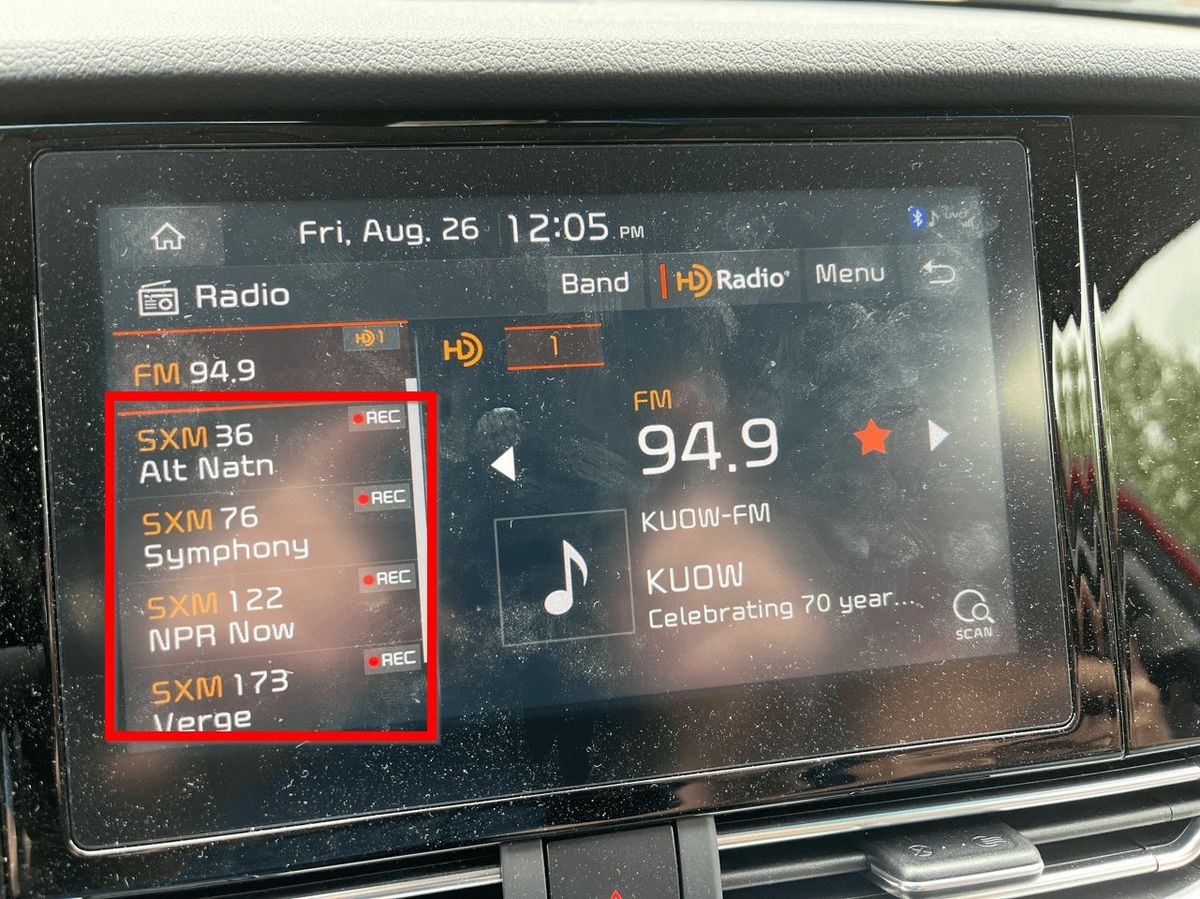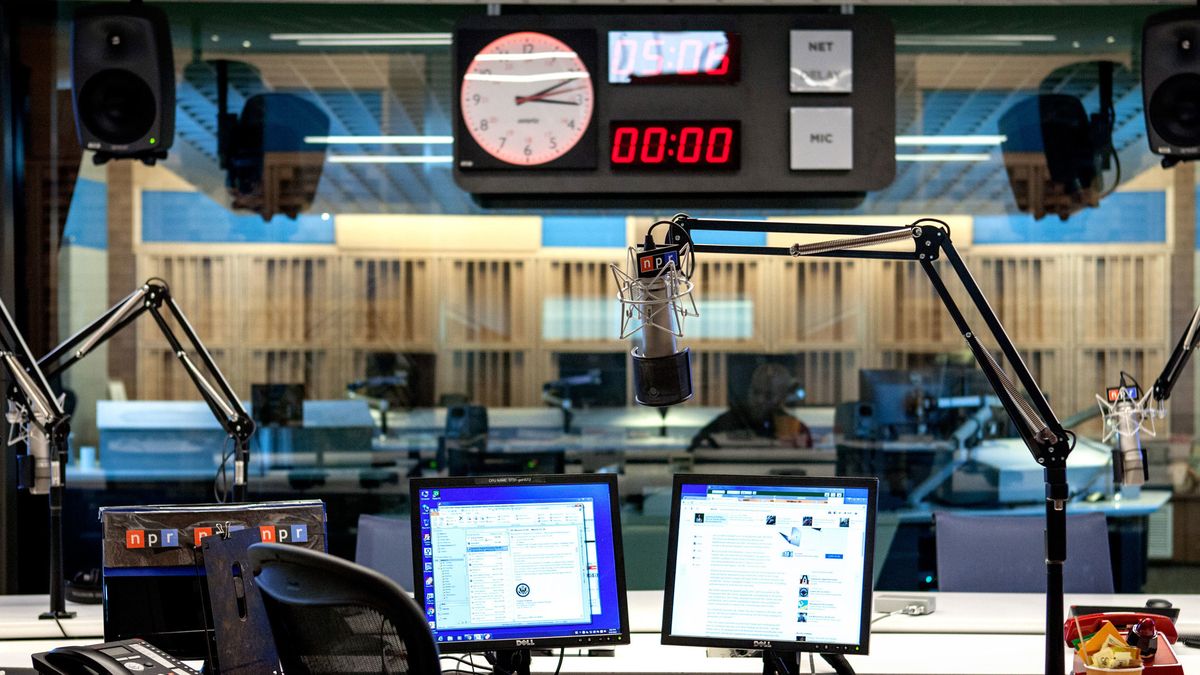Home>Devices & Equipment>Radio>How To Start A Radio Station Fm


Radio
How To Start A Radio Station Fm
Modified: January 22, 2024
Looking to start your own FM radio station? Discover step-by-step instructions and essential tips for launching your radio station successfully.
(Many of the links in this article redirect to a specific reviewed product. Your purchase of these products through affiliate links helps to generate commission for AudioLover.com, at no extra cost. Learn more)
Table of Contents
- Introduction
- Understanding the Radio Station Industry
- Researching the Market and Demographics
- Acquiring the Necessary Licenses and Permits
- Selecting the Right Equipment and Technology
- Setting Up a Studio
- Building a Music Library
- Developing Programming and Format
- Hiring and Training Staff
- Marketing and Promoting Your Radio Station
- Maintaining and Managing Your Radio Station
- Conclusion
Introduction
Starting a radio station can be an exciting and fulfilling venture for those passionate about music, communication, and broadcasting. Radio has been an integral part of our lives for decades, providing entertainment, news, and a platform for local voices to be heard.
Today, with the advancements in technology and the rise of internet radio, starting a radio station has become more accessible than ever before. Whether you’re interested in launching a community radio station, an internet radio station, or even a traditional FM station, the key is to understand the industry, do thorough research, and make informed decisions.
In this article, we will guide you through the process of starting your own radio station, covering everything from market research and acquiring licenses to setting up a studio and programming your content.
We will also delve into the importance of understanding your target audience, building a music library, and hiring and training staff to ensure the success of your radio station.
Additionally, we’ll discuss the crucial aspects of marketing and promotion, as well as maintaining and managing your radio station once it’s up and running.
So get ready to embark on a journey into the dynamic world of radio broadcasting. Whether you’re an aspiring radio host, a music enthusiast, or an entrepreneur looking for a new venture, this comprehensive guide will provide you with the necessary insights and steps to start your own radio station.
Remember, starting a radio station requires dedication, hard work, and a deep understanding of the industry. But with the right knowledge and passion, you can create a platform that not only entertains and informs, but also connects and engages with your audience in a meaningful and powerful way.
Understanding the Radio Station Industry
Before diving into the process of starting your own radio station, it’s crucial to have a solid understanding of the radio station industry. Radio broadcasting has a rich and diverse history, and staying informed about the current landscape will help you make informed decisions and set realistic expectations.
The radio industry can be divided into different segments, including commercial radio, public radio, and internet radio. Commercial radio stations generate revenue through advertising, while public radio stations rely on donations from listeners and sponsorships. Internet radio stations, on the other hand, have gained popularity in recent years, offering a wide variety of specialized content and reaching a global audience via online streaming.
It’s also important to be aware of the various formats and genres within the radio industry. Formats refer to the style and content of the radio station, such as pop, rock, country, talk radio, and sports radio. Understanding the preferences and demographics of your target audience will help you choose the right format for your radio station.
In addition, staying up-to-date with technological advancements in the industry is crucial. Traditional AM/FM radio stations are still prevalent, but the internet and mobile devices have revolutionized the way we consume radio content. Online streaming, podcasting, and mobile apps have opened new avenues for radio broadcasting and increased accessibility for listeners around the world.
Furthermore, it’s important to keep an eye on industry trends and changes in listener behavior. For example, the rise of streaming services and personalized music platforms has influenced how people discover and consume music, which can impact the programming decisions of radio stations.
By staying informed about the industry landscape, you’ll be able to identify opportunities, anticipate challenges, and make strategic decisions when starting your own radio station. It’s also beneficial to network with professionals in the industry, attend industry events, and seek mentorship from experienced broadcasters to gain insights and knowledge.
Now that you have a better understanding of the radio station industry, it’s time to move on to the next step: researching the market and understanding your target audience.
Researching the Market and Demographics
Researching the market and understanding your target audience is a critical step in starting a successful radio station. By gathering data and insights about your local community or target market, you can tailor your programming and content to meet the needs and preferences of your listeners.
Start by conducting market research to gain a deep understanding of the radio landscape in your area. Identify existing radio stations, their formats, and their target demographics. Evaluate their strengths, weaknesses, and opportunities to identify gaps and potential niches that your station can fill.
Consider the demographics of your target audience, including age, gender, income level, interests, and preferences. This information will help you determine the type of content, music genres, and programming that will resonate with your audience.
Utilize surveys, focus groups, and online research tools to collect data about your target audience’s preferences and listening habits. Analyze the data to identify the most popular music genres, preferred time slots, and potential demand for specific types of content.
Furthermore, stay up-to-date with local events, news, and cultural trends that can influence your audience’s interests and preferences. This will enable you to create relevant and engaging content that keeps your listeners hooked.
Once you have a clear understanding of your target audience and their preferences, it’s time to develop your station’s unique selling proposition (USP). What sets your station apart from others? Define your station’s brand, core values, and the benefits it offers to your listeners.
Your USP could be a specific music genre that is underrepresented in your area, an emphasis on local content and community engagement, or a unique approach to storytelling and programming. Clearly articulating your USP will help you attract and retain loyal listeners.
Remember, radio is a personal and intimate medium. Building a connection with your audience is essential. Take the time to interact with your listeners through social media, emails, and events. Engage with their feedback, requests, and suggestions to continuously improve your content and strengthen the relationship between your station and its audience.
Once you have a thorough understanding of the market and demographics, you can move forward with the next steps of acquiring the necessary licenses and permits for your radio station.
Acquiring the Necessary Licenses and Permits
Before you can legally operate your radio station, it’s important to obtain the necessary licenses and permits. This ensures that you are compliant with the regulations and guidelines set by the relevant authorities in your country or region.
The specific licenses and permits needed may vary depending on factors such as the type of radio station you intend to start and the country or region you are operating in. However, there are some common licenses and permits that most radio stations require.
The first and most crucial license is the broadcasting license. This is typically issued by the regulatory authority responsible for overseeing broadcasting in your country or region. The process of obtaining a broadcasting license can vary in complexity and requirements. It may involve submitting an application, providing a business plan, demonstrating technical capability, and paying any associated fees.
In addition to the broadcasting license, you may also need to obtain other permits and licenses. These could include music licensing agreements to legally play copyrighted music, especially if you plan on broadcasting commercial music. This typically involves entering into agreements with performance rights organizations (PROs) such as ASCAP, BMI, or SESAC. These organizations collect royalties on behalf of songwriters and publishers and distribute them accordingly.
If you plan on broadcasting live events, interviews, or phone-ins, you may also need to obtain consent or release forms from individuals involved. This ensures that you have the necessary legal permissions to broadcast their voices or content.
It’s important to thoroughly research the legal requirements in your specific jurisdiction and consult with a legal professional or broadcasting association to ensure that you are fully compliant. Failure to obtain the appropriate licenses and permits can result in penalties or even the forced shutdown of your radio station.
Once you have acquired the necessary licenses and permits, it’s important to keep them up to date and ensure ongoing compliance with regulations. This may involve regular reporting, paying fees, and adhering to any content restrictions or advertising guidelines imposed by the regulatory authority.
By obtaining the required licenses and permits, you can establish your radio station as a legitimate and trustworthy broadcaster. This instills confidence in your audience and opens up opportunities for partnerships, sponsorships, and advertising revenue.
With the licenses and permits in place, you can now focus on selecting the right equipment and technology for your radio station.
Selecting the Right Equipment and Technology
Choosing the right equipment and technology is essential for the successful operation of your radio station. The equipment you select will determine the quality of your broadcasts and the overall experience for your listeners. Here are some important considerations when selecting the right equipment and technology.
1. Studio Equipment: The heart of your radio station is the studio, where you and your staff will be hosting shows and producing content. Invest in high-quality microphones, headphones, mixers, and audio interfaces to ensure clear and professional sound. Consider the number of hosts and guests you anticipate having and choose equipment that can accommodate your needs.
2. Broadcasting Software: Use professional broadcasting software to manage your content and automate broadcasting tasks. Look for software that allows you to schedule playlists, manage advertisements, and integrate external sources such as phone calls or live interviews. Some popular broadcasting software options include SAM Broadcaster, RadioDJ, and PlayIt Live.
3. Transmitter and Antenna: If you’re starting an FM radio station, you’ll need a transmitter and an antenna to broadcast your signal. Consult with experts in the field to determine the appropriate power output and coverage range for your specific location. Consider factors such as distance, terrain, and local regulations when selecting the right transmitter and antenna combination.
4. Streaming Equipment: If you plan to broadcast your radio station online or as an internet radio station, you’ll need streaming equipment. This includes an encoder to convert your audio signal into a format that can be streamed online, as well as a reliable and scalable streaming server or service provider to handle the distribution of your stream to listeners worldwide.
5. Backup Systems: It’s important to have backup systems in place to ensure uninterrupted broadcasting. This includes backup power supplies, redundant internet connections, and backup equipment for critical components such as transmitters or audio interfaces. Consider investing in backup systems to minimize downtime and keep your station running smoothly.
6. Automation and Metadata Systems: Utilize automation software to schedule and automate specific tasks such as playing jingles, advertisements, or pre-recorded content. Additionally, metadata systems allow you to provide detailed information about the songs and artists you play, enhancing the listening experience and enabling listeners to discover new music.
When selecting equipment, consider your budget, the size and scale of your radio station, and your future growth potential. It’s recommended to consult with experts or audio professionals who can provide guidance and recommendations based on your specific needs and goals.
Remember, the equipment you choose will have a direct impact on the quality of your broadcasts, so it’s important to invest in reliable and high-quality equipment that meets the unique requirements of your radio station.
With the right equipment and technology in place, you can now move forward with setting up your studio and preparing for the launch of your radio station.
Setting Up a Studio
The studio is the creative hub of your radio station, where shows are hosted, content is produced, and the magic happens. Setting up a well-equipped and functional studio is essential for a smooth and professional broadcasting experience. Here are some key steps to consider when setting up your studio:
1. Find a Suitable Space: Choose a space that is quiet and free from external noise interference. If possible, opt for a room with soundproofing or add acoustic treatment to minimize echo and reverberation. Consider the size of the space, ensuring it is spacious enough to accommodate your equipment, hosts, and guests comfortably.
2. Layout and Design: Plan the layout of your studio to maximize efficiency and workflow. Arrange your equipment in a way that allows easy access and ergonomic positioning for hosts and operators. Consider factors such as cable management, ventilation, and lighting to create a comfortable and functional environment.
3. Acquire Essential Equipment: Invest in the necessary equipment for your studio, including microphones, headphones, audio interfaces, mixers, and computers. Choose equipment that suits your specific needs and budget, ensuring compatibility and reliability. Consider the number of hosts and guests you anticipate having and choose equipment accordingly.
4. Install Audio Routing System: Implement an audio routing system that allows you to route audio signals between various equipment and devices. This enables you to control and manipulate audio sources, apply effects, and manage audio levels seamlessly. Consider using digital audio workstations (DAWs) or audio routing software to streamline the process.
5. Configure Recording and Editing Software: Set up recording software, such as Adobe Audition or Audacity, to capture and edit your shows and segments. Configure the software to meet your specific requirements, including file formats, sample rates, and recording settings. Familiarize yourself with the software’s features and functionalities to maximize productivity.
6. Establish Communication Systems: Implement a communication system that allows hosts, producers, and operators to communicate effectively during live shows. This can be achieved through intercom systems, chat applications, or dedicated communication software. Clear and seamless communication is crucial for coordinating shows and ensuring smooth transitions.
7. Test and Optimize Audio Quality: Once your studio is set up, thoroughly test the audio quality to ensure a clear and professional sound. Set appropriate levels, test microphones, and listen for any unwanted noise or distortion. Consider using audio processing tools and equalizers to optimize audio quality and create a signature sound for your station.
8. Create a Comfortable Environment: Make your studio a comfortable space for hosts and guests. Consider adding comfortable seating, proper lighting, and a welcoming ambiance. This will help create a relaxed and creative atmosphere that enhances the quality of your broadcasts.
Remember, setting up a studio requires attention to detail and careful planning. Take the time to arrange your equipment, optimize audio quality, and create a space that inspires creativity and professionalism.
With your studio set up, you are ready to embark on building a music library and developing programming for your radio station.
Building a Music Library
A comprehensive and diverse music library is an essential component of a successful radio station. Your music library serves as the foundation of your programming, helping to captivate and engage your audience. Here are some key steps to consider when building your music library:
1. Define Your Music Genre and Format: Determine the genre(s) and format of music that align with your target audience and overall station brand. Whether it’s pop, rock, country, hip-hop, or a combination of genres, clearly define the type of music you want to showcase on your station.
2. Research and Discover New Music: Stay up-to-date with current trends and research new artists and songs. Utilize music streaming platforms, music blogs, industry publications, and local music events to discover emerging artists and new releases. Engage with your audience to gather input and suggestions for music they would like to hear on your station.
3. Collaborate with Independent Bands and Musicians: Foster relationships with independent artists and bands in your local area or within your genre of interest. By supporting and featuring independent talent, you can introduce unique and fresh music to your audience while helping artists gain exposure.
4. Acquire Music Licensing: Ensure that you have the necessary music licensing agreements in place to legally play copyrighted music. Establish agreements with performance rights organizations (PROs) such as ASCAP, BMI, or SESAC to cover the royalties for songwriters and publishers. Adhere to the licensing terms and reporting requirements set by these organizations.
5. Organize and Categorize Your Music: Develop a systematic approach to organizing and categorizing your music library. Consider using a digital music management software or a spreadsheet to keep track of your songs, artists, genres, and other relevant metadata. Create playlists and subcategories based on different moods, themes, or time periods to facilitate smooth programming and transitions.
6. Maintain a Balanced Rotation: Create a rotation schedule to ensure that your music library is played in a balanced and equitable manner. Avoid excessive repetition or favoring certain songs or artists. Regularly update and refresh your rotation to keep your content fresh and appealing.
7. Engage with Your Audience: Encourage your audience to participate in the programming by soliciting their feedback, song requests, and suggestions. Implement engaging features such as dedications, themed shows, or listener polls to increase audience interaction and involvement.
8. Consider Specialty Shows: In addition to your regular programming, consider hosting specialty shows that cater to specific music genres, decades, or themes. These shows can provide a more focused and niche listening experience, attracting dedicated audiences and enhancing the diversity of your music library.
Remember, building a music library is an ongoing process. Continuously research and add new music, update playlists, and adapt to the evolving tastes and preferences of your audience. Strive for a balance that satisfies your target demographic while also providing opportunities for discovery and artistic exploration.
With a robust music library in place, you can now focus on developing programming and format for your radio station.
Developing Programming and Format
Developing a strong programming strategy and format is crucial for the success of your radio station. The programming sets the tone, style, and content of your broadcasts, creating a unique experience for your listeners. Here are key steps to consider when developing your programming and format:
1. Identify Your Target Audience: Understand the demographics and preferences of your target audience. Consider factors such as age, gender, musical tastes, and interests. This knowledge will help you tailor your programming to resonate with your specific audience and build a loyal listener base.
2. Define Your Station’s Identity: Determine the overall identity and brand of your station. This includes the station’s name, logo, tagline, and core values. Consider how you want your station to be perceived and the image you want to project to your audience.
3. Choose a Format: Selecting a format will determine the style and content of your broadcasts. Popular formats include music-centric formats like Top 40, classic hits, alternative, or country, as well as talk radio formats like news, sports, or talk shows. Consider the interests and preferences of your target audience when choosing the format.
4. Create a Programming Schedule: Develop a schedule that outlines the timing and flow of your programming. Balance different show types, such as music shows, talk shows, and specialty shows, throughout the week. Consider peak listening times, commute hours, and popular time slots for maximum audience reach.
5. Determine Show Themes and Segments: Plan specific themes and segments for your shows to add variety and captivate your audience. These can include features like artist spotlights, listener dedications, interviews, or even contests and giveaways. Establishing recurring segments will create a sense of familiarity and anticipation among your listeners.
6. Establish Preferred Broadcast Length: Determine the duration of your shows and segments. This can range from a few minutes for short features or news updates to several hours for longer shows. Consider factors such as attention span, listener preferences, and your available content to determine the optimal length for each segment.
7. Engage with Listeners: Encourage audience interaction and engagement through live call-ins, social media participation, or online chat features. This creates a sense of community and connection for your listeners, making them feel involved and valued by the station.
8. Continuously Evaluate and Adapt: Regularly evaluate your programming to assess its effectiveness and make necessary adjustments. Monitor audience feedback, ratings, and listener behavior to identify areas for improvement. Stay informed about industry trends and adapt your programming to stay fresh and relevant.
Remember, developing programming and format takes time and experimentation. Be open to feedback and embrace the opportunity to evolve and refine your programming strategy as you gain insights and establish a stronger connection with your audience.
With your programming and format in place, it’s time to focus on hiring and training staff to support the operations of your radio station.
Hiring and Training Staff
Building a talented and dedicated team is essential for the smooth operation and success of your radio station. Hiring and training staff who align with the vision and goals of your station will help you create compelling content and provide a memorable experience for your listeners. Here are key steps to consider when hiring and training staff:
1. Define Roles and Responsibilities: Determine the specific roles and responsibilities needed for your station, such as DJs, producers, technicians, and administrators. Clearly outline the expectations and requirements for each role to attract candidates who possess the necessary skills and qualifications.
2. Advertise Job Openings: Promote your job openings through various channels, such as online job boards, social media platforms, industry forums, and local broadcasting schools. Craft engaging job descriptions that highlight the unique aspects and opportunities of working for your radio station.
3. Conduct Interviews and Auditions: Screen applicants through interviews and auditions to assess their suitability for the role. Evaluate their communication skills, knowledge of the industry, creativity, and passion for radio broadcasting. Consider conducting on-air auditions to gauge their on-air presence and ability to engage listeners.
4. Train New Hires: Once you’ve selected candidates, provide thorough training to familiarize them with station policies, equipment usage, broadcasting software, and on-air best practices. Offer mentoring, workshops, and resources to help them develop their skills and grow in their roles.
5. Foster Collaboration and Teamwork: Encourage a collaborative and supportive environment within your team. Promote cross-training and opportunities for staff members to learn from one another. This not only enhances their skillsets but also strengthens the overall operations of your station.
6. Provide Feedback and Performance Evaluations: Conduct regular performance evaluations to provide feedback to your staff members. Recognize their strengths and areas of improvement, and offer guidance on how they can enhance their on-air presence, content delivery, or technical skills. Establish an open and constructive feedback culture to foster continuous growth.
7. Promote Professional Development: Invest in the professional development of your staff through workshops, seminars, industry conferences, and networking opportunities. Encourage them to stay updated with industry trends and emerging technologies, enabling them to bring fresh ideas and perspectives to their work.
8. Nurture a Positive Work Culture: Create a positive and inclusive work culture that values teamwork, creativity, and respect. Foster a sense of belonging and camaraderie among your staff members. Celebrate achievements, encourage collaboration, and create opportunities for social bonding within your team.
Remember, building a strong and motivated staff is an ongoing process. Listen to their feedback, support their growth, and provide them with opportunities to thrive in their roles. With a dedicated team in place, you can move forward with marketing and promoting your radio station to attract and engage new listeners.
Marketing and Promoting Your Radio Station
Effective marketing and promotion are critical for attracting and engaging listeners to your radio station. By implementing strategic marketing efforts, you can increase brand visibility, build a loyal audience, and establish your station as a go-to destination for quality content. Here are key steps to consider when marketing and promoting your radio station:
1. Develop a Brand Identity: Define your station’s brand identity, including a compelling logo, tagline, and visual elements that resonate with your target audience. Your brand should evoke the desired emotions and reflect the values and personality of your station.
2. Create a Strong Online Presence: Build a professional website that showcases your station’s programming, on-air talent, and schedule. Optimize your website for search engines and ensure it is mobile-friendly. Use social media platforms to engage with your audience, share updates, and promote upcoming shows or events.
3. Utilize Social Media Marketing: Leverage the power of social media platforms to connect with existing and potential listeners. Regularly post engaging content, share behind-the-scenes insights, and respond to comments and messages. Consider running targeted social media advertising campaigns to reach a broader audience.
4. Collaborate with Local Businesses and Events: Form partnerships with local businesses, community organizations, and event organizers. Seek opportunities for cross-promotion, sponsorships, or hosting live broadcasts from local events. This can help increase your visibility and attract listeners who are interested in local content.
5. Produce Engaging Content: Develop compelling content that speaks to your target audience’s interests and preferences. Conduct interviews with local artists, experts, or influencers. Organize contests, giveaways, or listener challenges to encourage participation.
6. Utilize Email Marketing: Build an email list and utilize email marketing to communicate with your audience. Send regular newsletters containing updates, content highlights, and exclusive offers. Personalize your emails to ensure they resonate with each subscriber.
7. Engage with Influencers and Bloggers: Collaborate with influential bloggers, vloggers, or social media influencers who have an aligned audience. Seek opportunities for interviews, guest appearances, or sponsored content. Their endorsement can help introduce your station to new listeners.
8. Leverage Traditional Advertising Channels: Explore advertising opportunities in local newspapers, magazines, and radio trade publications. Consider sponsoring community events or radio programs that align with your target audience.
9. Monitor and Analyze Your Performance: Regularly monitor the success of your marketing efforts by analyzing metrics such as website traffic, social media engagement, email open rates, and listener feedback. Use this data to refine your strategies and focus on what resonates most with your audience.
10. Engage with your community: Participate in local events, charity activities, or community initiatives. Engaging with your community demonstrates your commitment and strengthens your connection with your local audience.
Remember, consistency and creativity are key when marketing and promoting your radio station. Continuously assess and refine your strategies to ensure they align with your target audience’s preferences and evolving industry trends. By effectively marketing your station, you can expand your listener base and establish a strong position in the radio industry.
With your marketing efforts underway, it’s important to focus on the maintenance and management of your radio station to ensure its continued success.
Maintaining and Managing Your Radio Station
Maintaining and managing your radio station is crucial for its ongoing success and smooth operation. Effective management ensures that your station delivers consistent and high-quality programming, maintains compliance with regulations, and keeps the audience engaged. Here are key steps to consider when maintaining and managing your radio station:
1. Regular Equipment Maintenance: Implement a schedule for routine maintenance and inspection of your equipment. This includes checking, cleaning, and calibrating audio equipment, transmitters, and antennas. Set up a backup system to minimize downtime in case of equipment failure.
2. Compliance with Regulations: Stay up-to-date with broadcasting regulations and ensure ongoing compliance. Monitor changes in licensing requirements, content restrictions, and advertising guidelines. Maintain detailed records and reports required by regulatory bodies and promptly address any issues or violations that may arise.
3. Content Quality Control: Establish a system for quality control to ensure that your programming meets the highest standards. Regularly review and evaluate the content being broadcasted, paying attention to audio quality, accuracy, relevance, and adherence to station policies. Encourage feedback from listeners and address any concerns or complaints promptly.
4. Engage and Train Staff: Maintain open lines of communication with your staff and provide ongoing training and development opportunities. Foster a positive work environment that encourages teamwork, creativity, and continuous learning. Conduct regular team meetings, coaching sessions, and performance evaluations to provide feedback, address challenges, and recognize achievements.
5. Programming Evaluation and Innovation: Continuously review and evaluate your programming to identify areas for improvement and innovation. Monitor audience feedback, ratings, and trends to gauge the effectiveness of your content. Stay informed about emerging technologies, industry trends, and listener preferences to adapt and update your programming accordingly.
6. Audience Interaction and Engagement: Foster a strong connection with your audience through various channels. Encourage listeners to provide feedback, song requests, and suggestions. Utilize social media, live call-ins, contests, surveys, or listener panels to engage with your audience and make them feel valued and involved.
7. Adapting to Technology Changes: Stay updated with technological advancements in the broadcasting industry. Embrace new platforms, streaming technologies, and digital distribution channels to expand your reach and accessibility. Develop a robust online presence and explore ways to leverage digital platforms for engagement, content distribution, and monetization.
8. Financial Management: Establish sound financial management practices to ensure the sustainability of your radio station. Maintain accurate accounting records, monitor expenses, and plan for revenue generation through advertising, sponsorships, partnerships, or listener donations. Seek professional financial advice if necessary.
9. Continual Promotion and Marketing: Maintain a consistent and strategic marketing and promotion plan. Keep your brand visible and regularly engage with your audience through social media, email newsletters, community events, and collaborations. Monitor the effectiveness of your marketing strategies and adjust them based on audience response.
10. Listener Relationship Management: Build and nurture relationships with your audience. Show appreciation for their ongoing support through special promotions, exclusive content, and personalized communication. Implement effective customer relationship management strategies to foster loyalty and encourage listeners to become brand advocates.
By diligently maintaining and effectively managing your radio station, you can ensure its long-term success in an ever-changing industry. Continuously strive for excellence, adapt to innovations, and remain connected with your audience to create a lasting impact in the world of radio broadcasting.
With all these aspects in mind, you are now equipped to launch and operate a successful radio station. Dedication, creativity, and a deep passion for the medium are key ingredients for building a unique and impactful radio experience.
Conclusion
Embarking on the journey of starting and operating a radio station is an exciting and rewarding endeavor. With the right knowledge, preparation, and dedication, you can create a platform that entertains, informs, and connects with your audience. Through understanding the radio industry, conducting market research, acquiring licenses, and selecting the right equipment, you can lay a solid foundation for your station.
Building a music library, developing programming and format, and hiring and training a talented team will ensure that you create compelling content that resonates with your target audience. Implementing effective marketing and promotion strategies will help you attract and engage listeners, while maintaining and managing your station will ensure its ongoing success.
Remember, radio is a personal and powerful medium that has the potential to leave a lasting impact on the lives of your listeners. By continuously striving for excellence, adaptability, and innovation, you can stay ahead in the ever-evolving landscape of radio broadcasting.
Whether you’re starting a community radio station, an internet radio station, or a traditional FM station, your passion for music, communication, and the power of radio is what will drive your success. Embrace the opportunities, challenges, and joys that come with running a radio station, and endeavor to create an experience that captivates and inspires your listeners.
So go ahead, follow your dreams, and ignite the airwaves with your unique voice, creativity, and passion. Your radio station has the potential to become a beloved and influential presence in the lives of your listeners. Good luck on your journey, and may your radio station shine brightly in the vast spectrum of broadcasting.











